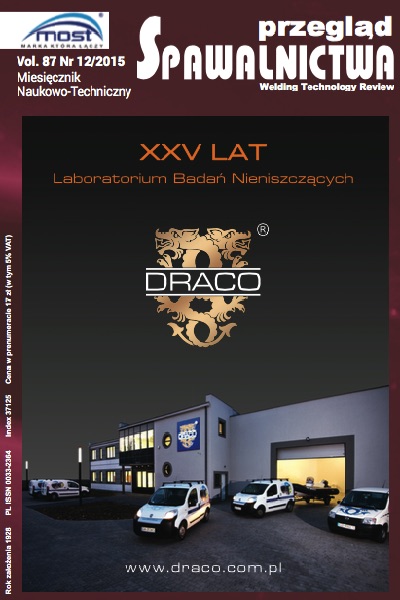Lokalizacja imperfekcji w płycie betonowej za pomocą metody tomografii ultradźwiękowej
Main Article Content
Abstract
W artykule przedstawiono zastosowanie tomografu ultradźwiękowego do lokalizacji imperfekcji w płycie betonowej dostępnej jednostronnie. Wykorzystano w tym celu opracowaną metodykę nieniszczącego badania elementów z betonu z wykorzystaniem najnowszej nieniszczącej metody akustycznej tomografii ultradźwiękowej. Badania przeprowadzono na obiekcie rzeczywistym będącym w trakcie remontu. Do badań wytypowano obszar, co do którego zachodziło podejrzenie występowania imperfekcji materiałowej, ponieważ w trakcie wiązania betonu obszar ten został zalany przez wodę opadową. Wykonano badania nieniszczące z wykorzystaniem tomografu ultradźwiękowego, na podstawie których zlokalizowano miejsce występowania imperfekcji materiałowej.
Localization of the imperfections in the concrete slab using ultrasonic tomography
Abstract
The article describes the use of an ultrasound tomography to locate the place of imperfections in the concrete slab. For this purpose developed methodology for non-destructive testing of concrete elements using the latest non-destructive method of acoustic ultrasonic tomography was used and study was conducted on a real object which is under renovation. The test site, on which occurred the suspicion of imperfection, because during concrete bonding area was flooded by rainwater. Non- destructive testing was performed using an ultrasonic tomography, on the basis of which localized the place of material imperfection.
Downloads
Article Details
Creative Commons CC BY 4.0 https://creativecommons.org/licenses/by/4.0/
Welding Technology Review (WTR) articles are published open access under a CC BY licence (Creative Commons Attribution 4.0 International licence). The CC BY licence is the most open licence available and considered the industry 'gold standard' for open access; it is also preferred by many funders. This licence allows readers to copy and redistribute the material in any medium or format, and to alter, transform, or build upon the material, including for commercial use, providing the original author is credited.
References
Rozporządzenie Ministra Infrastruktury z dnia 12.04.2002 r. w sprawie warunków technicznych jakim powinny odpowiadać budynki i ich usytuowanie (Dz. U. Nr. 75 poz. 690 z 2002r. z późniejszymi zmianami).
Schabowicz K.: Modern acoustic techniques for testing concrete structures accessible from one side only, Archives of Civil and Mechanical Engineering, DOI: 10.1016/j.acme.2014.10.001.
Schabowicz K.: Ultrasonic tomography the latest nondestructive technique for testing concrete members description, test method- ology, application example, Archives of Civil and Mechanical Engi- neering, 2014, Vol. 14, No. 2, 295-303.
Schabowicz K., Suvorov V.: Nondestructive testing of a bottom surface and construction of its profile by ultrasonic tomography, Russian Journal of Nondestructive Testing, 2014, Vol. 50, No. 2, 109-119.
Gorzelańczyk T., Hoła J., Sadowski Ł., Schabowicz K.: Methodology of nondestructive identification of defective concrete zones in unilaterally accessible massive members, Journal of Civil Engineering and Management, 2013, Vol. 19, No. 6, 775-786.
Schabowicz K.: Methodology for non-destructive identification of thickness of unilaterally accessible concrete elements by means of state-of-the-art acoustic techniques, Journal of Civil Engineering and Management , 2013, Vol. 19, No. 3, 325-334.
Schabowicz K., Hoła J.: Nondestructive elastic-wave tests of foundation slab in office building, Materials Transactions, 2012, Vol. 53, 296-302.
Hoła J., Sadowski Ł., Schabowicz K.: Nondestructive identification of delaminations in concrete floor toppings with acoustic methods, Automation in Construction, 2011, Vol. 20, 799-807.
Hoła J., Schabowicz K.: State-of-the-art non-destructive methods for diagnostic testing of building structures - anticipated development trends, Archives of Civil and Mechanical Engineering, 2010, Vol. X, Nr 3, 5-18.
